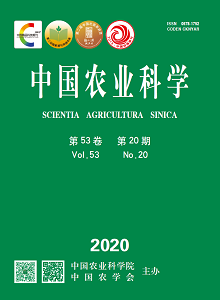【Objective】To address the problem of low wheat yield and water efficiency caused by irregular distribution of natural precipitation season and the frequent rate of staged drought in the Huang-Huai-Hai Plain of China, this paper provided theoretical as well as technical provisions for water-saving cultivation of winter wheat in this area by exploring the effects of water insufficiency on the main stem and tiller spikes formation and panicles traits during jointing stage.【Method】A 2-year pot experiment under external rain conditions was carried out from 2017 to 2019 in winter wheat growth season, and the two winter wheat varieties of Shannong 29 and Heng 0628 were used as experimental materials. The total five water treatments were set up during 0-10 d after jointing, including full irrigation treatment during whole growing season as control (CK, maintaining soil relative water content of 75%-80%, the effective soil water content of 42.2-46.7 mm), 0-5 d light drought stress after jointing (T1, maintaining soil relative water content of 65%-70%, soil availability water content of 33.4-37.8 mm), 0-5 d severe drought (T2, maintaining soil relative water content of 45%-50%, available soil water capacity is 15.6-20.1 mm), 0-10 d light drought stress after jointing (T3, maintaining soil relative water content is 65%-70%, soil availability water content of 33.4-37.8 mm), and 0-10 d severe drought stress (T4, maintaining the soil relative water content 45%-50%, availability water content of 15.6-20.1mm).【Result】The results revealed that different degrees of drought stress had no significant effect on the main stem of wheat during 0-10 d after jointing, the effective spike rate of low tiller (Ⅲ, Ⅰp ) decreased rapidly with the increasing the drought level and extension of drought time, while the effective spike rate of high tiller (Ⅱp and Ⅰ1) increased first and then decreased. Light or severe drought at 0-5 d after jointing stage, Ⅱp and Ⅰ1 were higher in effective spike rate, and there was no significant difference in spike number per unit area from CK. Although the effective spike rate of Ⅰ1 and Ⅱp was similar to that of CK in 0-10 d light drought after jointing stage, the percentage of spikes per unit area decreased significantly due to the decrease of Ⅲ, Ⅰp and Ⅳ. The number of spike per unit area of Shannong 29 and Heng 0628 was decreased by 4.94%-5.06% and 6.77%-8.33%, respectively. For 0-10 d light drought after jointing, the effective rate of tiller of Ⅱ and more was decreased of severe drought. The number of spikes per unit area of Shannong 29 and Heng 0628 was decreased by 10.97%-11.52% and 15.00%-15.55%, respectively. The treatment of light drought at 0-5 d after jointing stage, the panicle characteristics, single stem grain yield and grain yield per unit area of the two cultivars were not significantly different from CK. The treatment of severe drought from 0 to 5 days after jointing, the fertile spikelets number and the grain number in the two cultivars were significantly reduced, and the main stem and later occurring tillers were not affected. The single grain weight of Shannong 29 was not affected, but the yield of single stem grain yield was significantly reduced, the single grain weight and single stem grain yield of Heng 0628 was significantly reduced, the grain yield per unit area of Shannong 29 and Heng 0628 decreased significantly, which was 5.14%-5.46% and 5.45%-6.24% lower than CK, respectively. For the light and severe drought from 0 to 10 days after jointing, the spikelets number, the fertile spikelets number, grain number, single grain weight, single stem grain yield and grain yield per unit area of the two cultivars were significantly reduced; The median tillers had substantial reduction; The number of grains per ear and the yield of single-stem grain and the grain yield per unit area of severely drought-treated stems were significantly lower than those of light drought treatment. Under the T3 condition, the grain yield per unit area of Shannong 29 and Heng 0628 was decreased by 12.87%-13.30% and15.52%-16.59%, respectively. Under the T4 condition, the grain yield per unit area of Shannong 29 and Heng 0628 decreased by 23.18%-25.92% and 26.05%-31.22%, respectively.【Conclusion】The above results indicated that short-term light drought after jointing (0-5 days after jointing, maintaining soil relative water content of 65%-70% and soil effective water content of 33.4-37.8 mm) had no significant effects on wheat earing and fruiting; The percent of tillers to panicle, the spikelets number, the fertile spikelets number, grain number, single grain weight and single stem grain yield of the low tillers (Ⅲ, Ⅰp) would be greatly reduced, and the grain yield per unit area was significantly reduced increased drought stress and time. However, the effective spike rate of high tillers (Ⅱp and Ⅰ1) in two degrees of 0-5 d after jointing and light drought training of 0-10 d after jointing was increased to some extent, which could make up for the loss caused by drought, which might be related to the decrease of the effective spike rate of low tillers, the decrease of population size, and the increase of nutrition and living space for high tillers. Shannong 29 had the stronger potential to adapt drought stress at jointing stage than Heng 0628.









